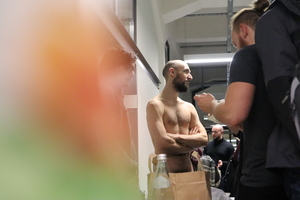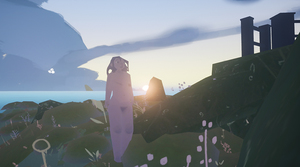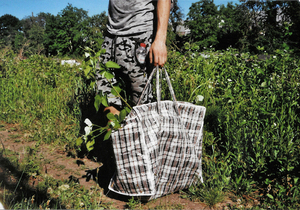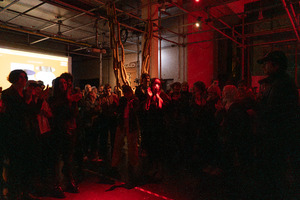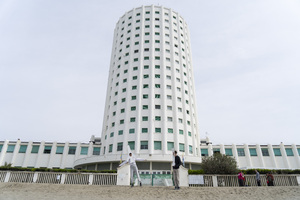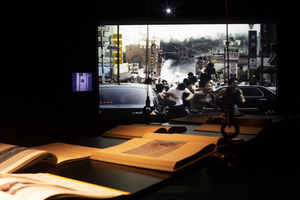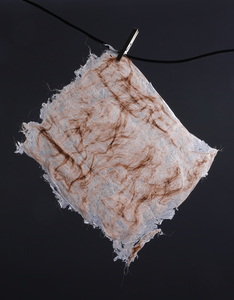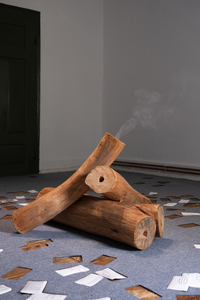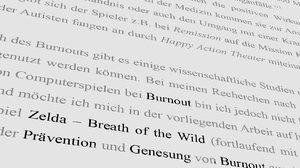Sets
288 Inhalte
- Seite 1 von 24
Vakna - Diplompräsentation
- Titel
- Vakna - Diplompräsentation
- Untertitel
- Der menschliche Körper. Das Wiederentdecken. Das Akzeptieren. Das Erwachen
- Autor/in
- Beschreibung (de)
- Vakna ist ein Spiel, das die Reise in das eigene (von der Gesellschaft beeinflusste) Denken ermöglicht und sowohl das Denken selbst als auch die eigenen Verhaltensweisen und eigenen Gefühle zum unbekleideten, menschlichen Körper hinterfragt.
Die Diplompräsentation wurde demzufolge ohne bedeckende, verdeckende, versteckende, verkleidende und betäubende Kleidung gehalten. Auch die Gestaltung der Räumlichkeiten wurde auf eine Weise vorbereitet, sodass eine Verbindung zur Diplomarbeit hergestellt und vor Ort ein Hinterfragen und Erleben mit den Sinnen stattfinden konnte.
- Vakna ist ein Spiel, das die Reise in das eigene (von der Gesellschaft beeinflusste) Denken ermöglicht und sowohl das Denken selbst als auch die eigenen Verhaltensweisen und eigenen Gefühle zum unbekleideten, menschlichen Körper hinterfragt.
- Ort
- HfG Karlsruhe
- Internetlinks
- Titel
- Vakna - Diplompräsentation
- Semester
- Importiert am
- 17.12.2018
- Übergeordnete Sets
- 1
- Set enthält
- 0 27
Vakna
- Titel
- Vakna
- Titel (en)
- Vakna
- Untertitel
- Der menschliche Körper. Das Wiederentdecken. Das Akzeptieren. Das Erwachen
- Autor/in
- Beschreibung (de)
- Der menschliche Körper.
Das Wiederentdecken.
Das Akzeptieren.
Das Erwachen.
Diese Gedanken sind der Beginn des Spiels Vakna, einer Gedankenwelt, die sich mit der Wahrnehmung und der Akzeptanz des unbekleideten menschlichen Körpers befasst und dadurch gesellschaftliche Einflüsse hinterfragt.
In dieser Gedankenwelt ist es dem/der Spieler/in möglich durch auffindbare Fragen und Aussagen mehr über sich selbst, die eigene Wahrnehmung, das eigene Verhalten, die eigene Moral und die eigenen rituellen Gedankengänge den menschlichen Körper betreffend herauszufinden.
Die Gedankenwelt Vakna erwacht gemeinsam mit der spielenden Person, welche vielleicht beginnt die eigene Wahrnehmung, das eigene Verhalten, die eigene Moral und die eigenen rituellen Gedankengänge den menschlichen Körper betreffend zu hinterfragen, für sich selbst und gegenüber anderen Menschen neu zu ordnen oder zu verändern.
Am Ende dieses Spiels hat jede Person für sich selbst zu entscheiden, ob das Wiedererwachen des Körpers und damit verbundene „Neu-Erleben“ der Welt ausprobiert oder gelebt werden möchte.
Auch sind die Fragen zu beantworten, wie mit der neugewonnen Akzeptanz und Wiederentdeckung umzugehen ist. Doch hat die spielende Person bei dieser Entscheidung sich nicht dem Spiel gegenüber zu verantworten, sondern sich selbst und den Mitmenschen der Gesellschaft.
Bei diesem Computerspiel handelt es sich um einen Single-Player im Bereich der Serious- und Educational-Games, das mit Tastatur und Maus gespielt werden kann.
- Der menschliche Körper.
- Beschreibung (en)
- The human Body.
The Rediscovery.
The Accepting.
The Awakening.
These thoughts are the beginning of the game Vakna, a world of thoughts that deals with the perception and acceptance of the human body without clothes, thereby questioning social influences.
In this world of thoughts it is possible for the player to find out more about himself, his own perception, his own behavior, his own morality and his own ritual thoughts concerning the human body through discoverable questions and statements.
Vakna awakens together with the player. The player begins to question the own perception, the own behavior, the own morality and the own ritual thought processes concerning the human body and perhaps to rearrange or change them for themselves and for other people.
At the end of this game, each person has to decide for himself whether the body's reawakening and the „re-experiencing“ of the world would be tried out or lived.
Also, the questions to be answered are how to deal with the newly gained acceptance and rediscovery. But in this decision, the player does not have to answer to the game, but to himself and the fellow human beings of society.
This computer game is a single player in the field of serious and educational games that can be played with a keyboard and a mouse.
- The human Body.
- Typ des Projekts/Werks
- Schlagworte
- Datierung
- 21.11.2018
- Mitwirkende
- Sprache
- Material
- Technik/Verfahren/Formate
- Computerspiel für Windows
- Abmessungen
- 3D
- Ort
- Hochschule für Gestaltung Karlsruhe
- Stadt
- Land
- Internetlinks
- Titel
- Vakna
- Importiert am
- 16.11.2018
- Übergeordnete Sets
- 1
- Set enthält
- 1 21
Ungeordnete Zustände
- Titel
- Ungeordnete Zustände
- Titel (en)
- Disorderly Conditions
- Untertitel
- Abtrag I Fragmentierung I Zerfall I Austrag I Verschwinden: Kleingärten an der Stuttgarter Straße Karlsruhe
- Untertitel des Projekts/Werks (en)
- Removal I Fragmentation I Decay I Dismantling I Disappearance: Allotment gardens on Stuttgarter Straße in Karlsruhe
- Autor/in
- Beschreibung (de)
- Die Ausstellung "Ungeordnete Zustände" erzählt in unterschiedlichen Strängen von der Auflösung der Kleingärten an der Stuttgarter Straße in Karlsruhe. Leonie Mühlen beobachtete diese Bewegungen, dokumentierte sie und nahm selbst daran teil. Die gezeigte Sammlung ist ein Versuch den Ort zu begreifen und zu konservieren. Eben diesen Ort im Abbruch, der in seiner Unordnung und seinem Ungehorsam Refugium für viele Dinge und Wesen war.
- Beschreibung (en)
- The exhibition "Ungeordnete Zustände" tells the story of the dissolution of the allotment gardens on Stuttgarter Straße in Karlsruhe in various strands. Leonie Mühlen observed these movements, documented them and took part in them herself. The collection on display is an attempt to understand and preserve the place. Precisely this place in demolition, which in its disorder and disobedience was a refuge for many things and beings.
- Kategorie
- Schlagworte
- Datierung
- 09.06.2021 - 27.06.2021
- Mitwirkende
- Ort: Institution
- Ort
- Luisenstraße 32
- Stadt
- Land
- Titel
- Ungeordnete Zustände
- Projektleiter/in
- Semester
- Studiengang
- Typ der Abschlussarbeit
- Importiert am
- 17.06.2024
- Übergeordnete Sets
- 1
- Set enthält
- 2 17
UMBAU Launch 3: Chaining
- Titel
- UMBAU Launch 3: Chaining
- Internetlinks
- Titel
- UMBAU Launch 3: Chaining
- Importiert am
- 15.01.2025
- Übergeordnete Sets
- 2
- Set enthält
- 0 25
UMBAU Issue 3 Celebration
- Titel
- UMBAU Issue 3 Celebration
- Autor/in
- Beschreibung (de)
- Thursday our HfG online Journal UMBAU will celebrate it's 3rd Issue called CHAINING.
8pm / 18.01.24 / at HfG Forum
There will be a performance by the artist Elle Fierce at 20:30 They are a Trans Non-Binary, British born Jamaican-Irish artist and activist, classically trained in ballet and modern dance, and have performed on stages around the world, particularly in the UK and most recently as a Soloist at Oper Leipzig. Now a freelance artist, with a multi disciplinary approach to performance, combining their activism and life experience as a black trans body to create provocative works.
The event shows artworks by Lucia Mattes and Lars Pinkwart and hosts afterwards DJ sets by aswesome LaLa Tina and our very best Frankie Spiderweb.
Our first contributions feature Mascha Dilger, Matteo Pasquinelli and Ülkü Süngün.
With unchained hearts, your UMBAU Team // Paolo Caffoni, Charlotte Eifler, Yannick Fritz, Jule Köpke & Livia Lazzarini
- Thursday our HfG online Journal UMBAU will celebrate it's 3rd Issue called CHAINING.
- Beschreibung (en)
- Thursday our HfG online Journal UMBAU will celebrate it's 3rd Issue called CHAINING.
8pm / 18.01.24 / at HfG Forum
There will be a performance by the artist Elle Fierce at 20:30 They are a Trans Non-Binary, British born Jamaican-Irish artist and activist, classically trained in ballet and modern dance, and have performed on stages around the world, particularly in the UK and most recently as a Soloist at Oper Leipzig. Now a freelance artist, with a multi disciplinary approach to performance, combining their activism and life experience as a black trans body to create provocative works.
The event shows artworks by Lucia Mattes and Lars Pinkwart and hosts afterwards DJ sets by aswesome LaLa Tina and our very best Frankie Spiderweb.
Our first contributions feature Mascha Dilger, Matteo Pasquinelli and Ülkü Süngün.
With unchained hearts, your UMBAU Team // Paolo Caffoni, Charlotte Eifler, Yannick Fritz, Jule Köpke & Livia Lazzarini
- Thursday our HfG online Journal UMBAU will celebrate it's 3rd Issue called CHAINING.
- Schlagworte
- Datierung
- 18.01.2024
- Mitwirkende
- Ort: Institution
- Ort
- HfG Forum
- Stadt
- Land
- Internetlinks
- Titel
- UMBAU Issue 3 Celebration
- Importiert am
- 20.02.2024
- Übergeordnete Sets
- 0
- Set enthält
- 0 25
UMBAU
- Titel
- UMBAU
- Autor/in
- Beschreibung (en)
- UMBAU is an online journal for the promotion of art, research, and design emerging from Karlsruhe University of Arts and Design (HfG).
In 1992, a time of major socio-economic and technological change, the Karlsruhe University of Arts and Design was founded as a “digital Bauhaus.” UMBAU, an architectural term roughly translatable as “remodeling” (to take a given structure and adjust it to contemporary situations) addresses this heritage and introduces a moment of destabilisation. UMBAU welcomes trans-disciplinary modes of thinking through the situational, the unfinished, and the transitional.
Through bi-weekly contributions from international artists, scientists, philosophers, historians and designers, UMBAU captures up-to-date research, while its annual editorial themes enable an in-depth exploration of ideas.
Concept by
Matthias Bruhn, Katharina Weinstock.
Founded by
Katharina Weinstock.
Founding members
Ariana Dongus, Friederike Schäfer, Katharina Weinstock.
- UMBAU is an online journal for the promotion of art, research, and design emerging from Karlsruhe University of Arts and Design (HfG).
- Kategorie
- Typ des Projekts/Werks
- Internetlinks
- Titel
- UMBAU
- Importiert am
- 13.02.2025
- Übergeordnete Sets
- 1
- Set enthält
- 1 0
TOWER POWER
- Titel
- TOWER POWER
- Autor/in
- Beschreibung (de)
- TOWER POWER ist eine performative Untersuchung der architektonischen Formensprache und Symbolik des Torre Fiat in Marina di Massa, Italien - einem Turm aus der Zeit des italienischen Faschismus und Ausstellungsort des POST-COLONIA Festivals of Architecture and Imaginaries in Transition, für das die Arbeit entwickelt wurde.
Als in Architektur materialisierte Ideologie steht der Turm scheinbar unausweichlich für eine lineare, gewaltvolle Erzählung von Geschichte. Mithilfe von Ursula K. Le Guins „Carrier Bag Theory of Fiction“ (1986) befragt TOWER POWER die dem Turm eingeschriebenen Narrative und den Umgang mit einem derart aufgeladenen baulichen Erbe:
"Are we in an airplane? A column? A ‚fascio littorio‘? What would each scenario mean? […] It’s just a building, right?" (deutsche Übersetzung: "Sitzen wir in einem Flugzeug? Einer Säule? Einem „Fascio Littorio“? Was würde das jeweils bedeuten? […] Es ist doch nur ein Gebäude, oder?")
- TOWER POWER ist eine performative Untersuchung der architektonischen Formensprache und Symbolik des Torre Fiat in Marina di Massa, Italien - einem Turm aus der Zeit des italienischen Faschismus und Ausstellungsort des POST-COLONIA Festivals of Architecture and Imaginaries in Transition, für das die Arbeit entwickelt wurde.
- Beschreibung (en)
- TOWER POWER is a performative investigation of the formal language and architectural symbolism of the Torre Fiat in Marina di Massa, Italy - a tower built during the Italian Fascist era, and the venue of POST-COLONIA Festival of Architecture and Imaginaries in Transition we had been invited to explore and exhibit in.
Steeped in ideology, the tower’s architecture inescapably seems to stand for a linear, violent historiography. TOWER POWER investigates the narratives inscribed into the tower through the lens of Ursula K. Le Guin’s Carrier Bag Theory of Fiction and poses questions on how to deal with such a charged architectural legacy:
"Are we in an airplane? A column? A ‚fascio littorio‘? What would each scenario mean? […] It’s just a building, right?"
- TOWER POWER is a performative investigation of the formal language and architectural symbolism of the Torre Fiat in Marina di Massa, Italy - a tower built during the Italian Fascist era, and the venue of POST-COLONIA Festival of Architecture and Imaginaries in Transition we had been invited to explore and exhibit in.
- Kategorie
- Typ des Projekts/Werks
- Schlagworte
- Datierung
- 2025
- Mitwirkende
- Dank an
- Sprache
- Titel
- TOWER POWER
- Projektleiter/in
- Semester
- Studiengang
- Importiert am
- 27.06.2025
- Übergeordnete Sets
- 0
- Set enthält
- 0 8
Tide
- Titel
- Tide
- Titel (en)
- Tide
- Autor/in
- Beschreibung (de)
- Gezeiten sind dem Zyklus von Sonne, Erde und Mond unterworfen. Sie sind die Bewegung der Wassermassen des Ozeans, die an den Küsten als periodisches Ansteigen und Absinken des Meeresspiegels in Erscheinung tritt. [...] Gezeiten als Daseinsmetapher umreißen das fortlaufende Ausbalancieren von Kommen und Gehen, Anziehen und Abstoßen, Sich zeigen und entziehen. [...] "Tide" überträgt dieses Verständnis der Gezeiten in eine kontinuierliche, non-lineare Bewegung im Ausstellungsraum.
- Beschreibung (en)
- Tides are subject to the cycle of the sun, earth and moon. They are the movement of the water masses of the ocean, which appears on the coasts as a periodic rise and fall of the sea level. [...] Tides as a metaphor for existence outline the continuous balancing of coming and going, attracting and repelling, showing and withdrawing. [...] "Tide" translates this understanding of the tides into a continuous, non-linear movement in the exhibition space.
- Kategorie
- Schlagworte
- Datierung
- 01.07.2020 - 05.07.2020
- Dank an
- Francesca Audretsch
- Patrick Alan Banfield
- Lisa Bergmann
- Matthias Bruhn
- Anja Casser
- Hans Christ (Hans D. Christ)
- Jaya Demmer
- Hubert Distel
- Anja Dorn
- Lizzy Ellbrück
- Hanna Franke
- Christoph Funk
- Laurine Haller
- Maria Harder-Scheib
- Sascha Jungbauer
- Lydia Kähny
- Tobias Keilbach
- Iden Sungyoung Kim
- Alexander Knoppik
- Hanne König
- Susanne Kriemann
- Judith Milz
- Paulina Mimberg
- Andrej Mircev
- Andreas Müller
- Viktor Neumann
- Leonie Ohlow
- Jonas Piroth
- Anja Ruschival
- Thomas Rustemeyer
- Friederike Schäfer
- Sebastian Schäfer
- Karl-Heinz Scheib
- Ivo Scheib
- Corinna Scheib
- Josefine Scheu
- Hendrik Stoerk
- Lioudmila Voropai
- Leia Morgana Walz
- Petra Zimmermann
- Ort: Institution
- Ort
- Großes Studio
- Stadt
- Land
- Titel
- Tide
- Projektleiter/in
- Semester
- Studiengang
- Typ der Abschlussarbeit
- Importiert am
- 14.06.2024
- Übergeordnete Sets
- 1
- Set enthält
- 0 15
Thinking inside out
- Titel
- Thinking inside out
- Titel (en)
- Thinking inside out
- Untertitel
- ZKM & HfG Gesprächsreihe
- Untertitel des Projekts/Werks (en)
- HfG & ZKM Talk Series
- Autor/in
- Beschreibung (de)
- In der Vortragsreihe »thinking inside out« laden das ZKM und die HfG Karlsruhe dazu ein, den Blick über vertraute Grenzen hinaus zu wagen. Internationale Stimmen aus Philosophie, Literatur und Kunst treffen hier auf Studierende, Forschende, Kulturschaffende und interessierte Bürger:innen – für inspirierende Begegnungen, unerwartete Perspektiven und offene Diskussionen.
- Beschreibung (en)
- As part of the lecture series »thinking inside out«, ZKM and HfG Karlsruhe invite audiences to look beyond familiar boundaries. International voices from philosophy, literature, and the arts come together with students, researchers, cultural practitioners, and engaged members of the public—for inspiring encounters, unexpected perspectives, and open dialogue.
- Typ des Projekts/Werks
- Mitwirkende
- Ort: Institution
- Titel
- Thinking inside out
- Importiert am
- 13.05.2025
- Übergeordnete Sets
- 1
- Set enthält
- 1 0
There are Biocomposites Growing in My Garden
- Titel
- There are Biocomposites Growing in My Garden
- Titel (en)
- There are Biocomposites Growing in My Garden
- Beschreibung (de)
- Für das Eröffnungsfestival von Driving the Human am 20.–22.11.2020 trug das Bio Design Lab neben dem Panel-Programm mit dem Remote-Workshop „There are Biocomposites Growing in my Garden“ einen tragenden Programmpunkt bei. Vorab wurde hierzu in Zusammenarbeit mit dem ZKM ein Trailer produziert, welcher das Lab, sowie dessen Beteiligung an der ZKM Ausstellung „Critical Zones“, bisherige Aktivitäten und Materialien vorstellte und zur Eröffnung des Streaming-Festivals am Freitagabend gezeigt wurde. Anschließend ermöglichte ein technisches Set-Up mit mehreren Kameras einen Remote-Workshop, der das Panel-Programm des Festivals von Samstag bis Sonntag als Hands-On-Komponente ergänzte. Als Workshop-Leiter konnte hierfür Kim André Lange gewonnen werden. Der Alumni der HfG Karlsruhe, der bereits eine umfassende Recherche zu Bioplastik in seinen bisherigen Arbeiten vorweisen konnte, führte via Stream durch die zwei Tage. Offen für alle Interessierten, gab es so jeweils am Morgen eine einstündige Lecture, in der die Historie und materialtechnische Aspekte zu Bioplastik sowie dessen aktuelle Entwicklung und Einsatzbereiche vorgestellt wurden. Darauf folgte freies Experimentieren und Betreuung durch das Bio Design Lab Team mit Ina Grabosch und Julia Ihls. Da ein Arbeiten on-site Corona-bedingt allerdings nicht möglich war, mussten einige alternative Lösungen zur Umsetzung erdacht werden: So wurde im Vorfeld eine Einkaufsliste mit benötigten Materialien und Utensilien auf der ZKM- und BDL-Website kommuniziert. Während des Workshops begleitete ein Social Media Team die Arbeiten im Lab via Instagram auf den BioDesignLab und Driving The Human Kanälen. Entsprechend konnten die internationalen Teilnehmer dem Workshop-Programm live folgen, Fragen stellen und auch ihre eigenen Workshop-Ergebnisse mit der DtH-Community teilen. Den Abschluss des zweitägigen Programms bot eine Live-Q&A auf dem Bio Design Lab Instagram-Kanal. Hier diskutierten Grabosch, Ihls und Lange den Nutzen und die Grenzen des Bio-Materials, gaben Einblicke in die Workshop-Erzeugnisse und beantworteten offene Fragen der Community.
- Für das Eröffnungsfestival von Driving the Human am 20.–22.11.2020 trug das Bio Design Lab neben dem Panel-Programm mit dem Remote-Workshop „There are Biocomposites Growing in my Garden“ einen tragenden Programmpunkt bei. Vorab wurde hierzu in Zusammenarbeit mit dem ZKM ein Trailer produziert, welcher das Lab, sowie dessen Beteiligung an der ZKM Ausstellung „Critical Zones“, bisherige Aktivitäten und Materialien vorstellte und zur Eröffnung des Streaming-Festivals am Freitagabend gezeigt wurde. Anschließend ermöglichte ein technisches Set-Up mit mehreren Kameras einen Remote-Workshop, der das Panel-Programm des Festivals von Samstag bis Sonntag als Hands-On-Komponente ergänzte. Als Workshop-Leiter konnte hierfür Kim André Lange gewonnen werden. Der Alumni der HfG Karlsruhe, der bereits eine umfassende Recherche zu Bioplastik in seinen bisherigen Arbeiten vorweisen konnte, führte via Stream durch die zwei Tage. Offen für alle Interessierten, gab es so jeweils am Morgen eine einstündige Lecture, in der die Historie und materialtechnische Aspekte zu Bioplastik sowie dessen aktuelle Entwicklung und Einsatzbereiche vorgestellt wurden. Darauf folgte freies Experimentieren und Betreuung durch das Bio Design Lab Team mit Ina Grabosch und Julia Ihls. Da ein Arbeiten on-site Corona-bedingt allerdings nicht möglich war, mussten einige alternative Lösungen zur Umsetzung erdacht werden: So wurde im Vorfeld eine Einkaufsliste mit benötigten Materialien und Utensilien auf der ZKM- und BDL-Website kommuniziert. Während des Workshops begleitete ein Social Media Team die Arbeiten im Lab via Instagram auf den BioDesignLab und Driving The Human Kanälen. Entsprechend konnten die internationalen Teilnehmer dem Workshop-Programm live folgen, Fragen stellen und auch ihre eigenen Workshop-Ergebnisse mit der DtH-Community teilen. Den Abschluss des zweitägigen Programms bot eine Live-Q&A auf dem Bio Design Lab Instagram-Kanal. Hier diskutierten Grabosch, Ihls und Lange den Nutzen und die Grenzen des Bio-Materials, gaben Einblicke in die Workshop-Erzeugnisse und beantworteten offene Fragen der Community.
- Beschreibung (en)
- For the opening festival of Driving the Human on 20-22.11.2020, the Bio Design Lab contributed to the panel program and the remote workshop "There are Biocomposites Growing in my Garden". In advance, a trailer was produced in collaboration with the ZKM, which introduced the Lab and its participation in the ZKM exhibition "Critical Zones", previous activities and materials, and was shown at the opening of the streaming festival on Friday evening. Afterwards, a technical set-up with several cameras enabled a remote workshop that complemented the festival's panel program from Saturday to Sunday as a hands-on component. Kim André Lange was recruited to lead the workshop. The alumnus of the HfG Karlsruhe, who has already done extensive research on bioplastics in his previous work, led through the two days via stream. Open to all interested parties, there was a one-hour lecture in the morning in which the history and material-technical aspects of bioplastics as well as their current development and areas of application were presented. This was followed by free experimentation and supervision by the Bio Design Lab team with Ina Grabosch and Julia Ihls. Since it was not possible to work on-site at Corona, however, some alternative solutions had to be devised for implementation: For example, a shopping list of required materials and utensils was communicated in advance on the ZKM and BDL websites. During the workshop, a social media team accompanied the work in the lab via Instagram on the BioDesignLab and Driving The Human channels. Accordingly, international participants were able to follow the workshop program live, ask questions and also share their own workshop results with the DtH community. The two-day program concluded with a live Q&A on the Bio Design Lab Instagram channel. Here, Grabosch, Ihls and Lange discussed the benefits and limitations of biomaterials, provided insights into workshop deliverables and answered open questions from the community.
- Typ des Projekts/Werks
- Schlagworte
- Datierung
- 20.11.2020 - 22.11.2020
- Mitwirkende
- Material
- Ort: Institution
- Ort
- Bio Design Lab
- Stadt
- Land
- Beteiligte Institution(en)
- Titel
- There are Biocomposites Growing in My Garden
- Projektleiter/in
- Semester
- Importiert am
- 25.10.2023
- Übergeordnete Sets
- 1
- Set enthält
- 0 21
The Plenum – A Scripted Play
- Titel
- The Plenum – A Scripted Play
- Autor/in
- Beschreibung (de)
- "The Plenum – A Scripted Play" behandelt das performative, das rituelle und das gemeinschaftsbildende Moment des Plenums als Planungstreffen selbstverwalteter Gruppen im politischen und kulturellen Kontext.
Über den Zeitraum eines Jahres wurden "Plena" in unterschiedlichen Konstellationen durchgeführt, die die gruppeneigene Dynamik untersuchten und auf Basis eines sich verändernden Scripts, einem Theaterdrehbuch oder Code gleichend, in einer kollektiven Performance Ausdruck fanden.
Die dabei von der Gruppe gemachten Erfahrungen dienten nicht nur zur Dokumentation für Gewesenes, sondern wurden als neuer „Input“ sofort in das bestehende Script eingearbeitet. Das sich permanent verändernde Projekt konnte so nach Vorbild eines Computerprogramms transparent gestaltet werden und ermöglichte eine basisdemokratische Beteiligung aller Akteur:innen – unabhängig von präexistentem Wissen oder Erfahrungswerten.
Nach Vorbild von Jo Freemans Essay „The Tyranny Of Structurelessness“ stand das Schaffen offener und klarer Kommunikation bezüglich der eigenen Gruppenstruktur und deren „Balance of Power“ im Mittelpunkt der Treffen.
„The Plenum – A Scripted Play“ ist jedoch nicht nur ein reales Treffen einer politischen Gruppe, sondern schafft seine identitäre Notwendigkeit durch seine Schnittstelle mit der Simulation: Das Finden von Mehrheiten (oder Einstimmigkeiten), die Verteilung von Macht und Autorität innerhalb der eigenen Gruppe sowie der Entscheidungsfindungsprozess wurden in verschiedenen Modellen spielerisch erprobt und in ihren politischen und historischen Kontext eingeordnet. Der fiktive Aspekt der Treffen öffnete Spielräume zur Reflexion über das eigene Verhalten innerhalb von Gruppengefügen. Vielen dieser Simulationen dienten Computercodes, Brettspiele und politische Verfassungen zur Vorlage.
Einem jeden Treffen selbstverwalteter Gruppen wohnt immer – oft unbewusst – etwas Rituelles inne, das zum Schaffen der kollektiven Identität von hoher Bedeutung ist. Das Wiederholen planerischer Abläufe und die kodifizierten, gruppenspezifischen Kommunikationsregeln entscheiden über Zugehörigkeit zur Gruppe und sind identitäts- und sinnstiftend.
Was vom Plenum bleibt, sind Simulationsskizzen, ein (beinahe) gegründeter Verein, eine intensive Auseinandersetzung um Vergütungsmodelle in einer nonmonetären Mikrowirtschaft und das Erarbeiten nachhaltiger Strukturen für die eigene kulturelle und politische Praxis, die sich bis heute fortsetzen. Sichtbar von alledem ist nichts, außer die Spuren, die wir stigmergisch hinterlassen.
Diese Spuren: Der Raum, in dem wir uns treffen; das Feuer, um das wir uns versammeln; die Karten, aus denen wir ablesen können, was einmal besprochen wurde – und werden wird; und das Script, ein sich permanent veränderndes Programm, das es uns vielleicht einmal ermöglichen wird, eine sozial und ökologisch nachhaltige Existenz in der Kunst- und Kulturszene zu führen.
- "The Plenum – A Scripted Play" behandelt das performative, das rituelle und das gemeinschaftsbildende Moment des Plenums als Planungstreffen selbstverwalteter Gruppen im politischen und kulturellen Kontext.
- Beschreibung (en)
- "The Plenum - A Scripted Play" deals with the performative, ritual and community-building moment of the plenum as a planning meeting of self-organised groups in a political and cultural context.
Over the course of a year, "Plena" were held in different constellations, which examined the group's own dynamics and found expression in a collective performance based on a changing script, similar to a theatre script or code.
The experiences made by the group not only served to document what had already happened, but were also immediately incorporated into the existing script as new "input". The constantly changing project could thus be designed transparently, modelled like a computer program, and enabled the grassroots democratic participation of all actors - regardless of pre-existing knowledge or experience.
Inspired by Jo Freeman's essay "The Tyranny Of Structurelessness", the creation of open and clear communication regarding the group's own structure and its "balance of power" was at the centre of the meetings.
However, "The Plenum – A Scripted Play" is not just a real meeting of a political group, but creates its identitary necessity through its intersection with the simulation: finding majorities (or unanimity), the distribution of power and authority within one's own group and the decision-making process were playfully tested in various models and placed in their political and historical context. The fictitious aspect of the meetings opened up scope for reflection on one's own behaviour within group structures. Many of these simulations were based on computer codes, board games and political constitutions.
There is always – often unconsciously – something of ritual inherent to every meeting of self-governed groups, which is of great importance for creating a collective sense of identity. The repetition of planning processes and the codified, group-specific communication rules determine membership of the group and create identity and purpose.
What remains of the plenum are simulation sketches, an (almost) founded association, an intensive debate about remuneration models in a non-monetary micro-economy and the development of sustainable structures for one's own cultural and political practice, which continue to this day. None of this is visible, except for the traces that we stigmergically leave behind.
These traces: the space in which we meet; the fire around which we gather; the cards from which we can read what has been – and will be – discussed; and the script, a constantly changing programme that will perhaps one day enable us to lead a socially and ecologically sustainable existence in the world of art and culture.
- "The Plenum - A Scripted Play" deals with the performative, ritual and community-building moment of the plenum as a planning meeting of self-organised groups in a political and cultural context.
- Kategorie
- Typ des Projekts/Werks
- Datierung
- 07.03.2023 - 18.04.2024
- Sprache
- Ort
- Plenarwohnung, Atelier von K.-J. Overkott, Günther-Klotz-Anlage, Schlosspark, Stephanienstraße (bei Sven), Sophienstraße (bei Tim), auf dem Dach, ßpace.
- Stadt
- Land
- Titel
- The Plenum – A Scripted Play
- Projektleiter/in
- Studiengang
- Typ der Abschlussarbeit
- Importiert am
- 16.06.2024
- Übergeordnete Sets
- 1
- Set enthält
- 0 6
Theorie
- Titel
- Theorie
- Autor/in
- Titel
- Theorie
- Importiert am
- 20.12.2018
- Übergeordnete Sets
- 1
- Set enthält
- 0 3
